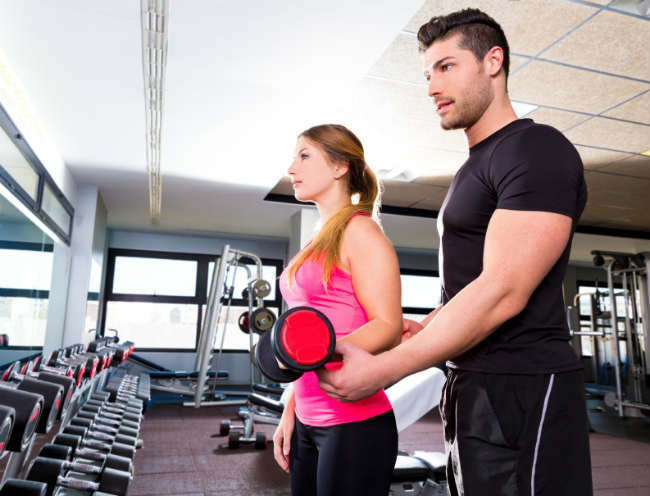If you want a strong abdomen (and take care of your health), stop doing sit-ups and train the core!
Having a strong abdomen and, above all, well marked and defined, is and will remain one of the main objectives of many people who come to the gym.
The point is that there are many errors and false beliefs around the subject of the abdominals , so we begin to clarify the issue.
There are no upper, lower and lateral abs
Yes, yes, even if you do not think so, these concepts continue to be heard in gyms and training centers, and the problem is that it is not only from users who are going to train, it is that even many coaches have these concepts in their heads.
We can not divide the musculature in parts . What does exist is the rectus abdominis, the internal and external obliques, the transversus abdominis, ….
If the goal is aesthetic, your percentage of body fat and your diet are absolutely key
The aesthetic end with the abdominals is very common (much less I am saying that this should be the main goal and of all), although, in turn, abdominal training is overrated .
It is simple, that your abdomen is more or less defined, that is, that it is marked more or less (aesthetic purpose), it will depend on your percentage of body fat .
It does not matter if you have the strongest abdomen in the world. If it is covered by a layer of grease it will not be marked. Therefore, if your goal is aesthetic and your abs are marked, your diet will be key .
In turn, you should consider that the shape of your abdomen is quite determined by your genetics , although I already tell you, body composition is key, and it is necessary to have a low percentage of body fat (around 12% or less) if You want to mark those abs.
More is not better and you can not lose fat in a localized way
The previous point is key, so I do not have to put a lot of emphasis on it.
It’s clear that doing more abdominals is not going to make them more marques , nor will it cause you to lose the fat of your abdomen. Let it be clear and I repeat once again: you can not lose fat in a localized way .
But it is not just this anymore. The point is that you should not do the typical abdominals .
For your health, do not do more abdominal crunch, sit ups or similar
That it has been done for many years and that it continues to be done does not mean that it is good . There are different scientific studies that show the possible risk of repeated abdominal crunch over time, especially in people who already have problems in the spine.
My partner Miguel Fitness already spoke about the detrimental effects of training the abdominal crunch a few days ago, and in this article I will remark many of them (we will inform about it as many times as it is necessary if this does not happen again).
Obviously because you do an abdominal crunch or five or ten you will not injure yourself. But the sum of repetitive abdominal crunches in the medium and long term (those typical abdominals in the floor where we flex the trunk, bringing the shoulders closer to the hips), besides not being so interesting at the level of global muscle activity, can cause next (and in people with problems in the column much more):
- Intervertebral discs subjected to pressure and wear with this column flexion (especially L5-S1), there being an increase in the pressure in the pulpy disc and compression of the medullary canal.
- Abdominal hyperpression that affects the pelvic floor.
- Ligamentous stress and increased tension in the neck , altering the cervical lordosis: we are favoring a posture that is not at all correct (make it clear that the abdominals never act to move the shoulders towards the hips).
- Traction of the iliopsoas (iliac psoas), which generates compression and compromise of the pulpy disc of the lumbar vertebrae : it has been demonstrated that the iliac psoas and the rectus abdominus have a very similar muscular activity in the abdominal crunch exercise, which indicates that The iliopsoas psoas is generating a lumbar compression that can lead to pain and damage at the lumbar level.
- Result of all the aforementioned: increase in the probability of suffering from hernias , prolapses, urinary incontinence and other problems .
By the way, adding a rotation, in addition to the column flexion ( flexion + column rotation ), as in the typical Russian gyrations, increases the possibility of intervertebral disc rupture by 25-50% , so do not ever do them.
Change your vision and know the true function of the abdomen: train the core
The function of the abdomen is not to cause movement (as in the famous crunchs), but precisely the opposite, to avoid it . Therefore, its function is stabilizing.
Stop doing specific crunches and train the famous core , which refers to a large number of muscles that make up the entire middle body area .
These muscles include the rectus abdominis, the internal and external obliques, the transversus abdominis, the psoas, the lumbar quadratus, the pelvic floor , the latissimus dorsi, the serratos, the spinal erectors of the spine, the multifidus, the musculature. of the hip, the buttocks , …
As I say, the function of the core is to stabilize the body and protect the spine , preventing it from moving, so, undoubtedly, we must train them for this function.
For this, the exercises are divided into three types (here I leave some of my favorites of each type):
- Anti-extension : front plate, front plate removing supports (lifting one leg or arm, for example), plates with forearms sliding on fitball, plates with sliding feet back (with towel or similar), abdominal wheel knees or standing , etc.
- Anti-lateral flexion : lateral plates and variants (forearm support, support of the hand, raise and lower a leg, raise and lower arm and leg, supports in different heights, ….), Farmer walks with dumbbell or kettlebell, etc. .
- Anti-rotation : pallof press with pulley or rubber band (standing, kneeling, static, dynamic), etc.
Therefore, the key to abdominal work is isometric exercises (muscle tension without movement), because, I repeat, the main function of the abdomen is not to provoke movement, but precisely the opposite, to avoid that this movement occurs and stabilize the spine .
Here you have a video (qualified professional training) in which different exercises and progressions are explained for the three types of core training exercises(anti-extension, anti-lateral bending and anti-rotation), in which you already know which of course will work properly and to a large extent your abdomen, do not hesitate.
At the same time, inform you that for this type of training the unstable surfaceslike the fitball , the bosu or the TRX can be very useful, generating instability and causing, therefore, a greater stabilizing work of our abdominal musculature and the rest of our core
For example, a frontal plate with forearms in fitball will have a greater activation of our abdominal muscles and the rest of our core than that same plate with forearms resting on the ground, because the instability of the fitball means that the stabilizing work of our muscles (between her the one of the abdomen) it must be greater not to move.
Even so, it is very important that you always choose according to your level and that you follow an adequate progression of these exercises.
Multiarticular exercises and unilateral exercises: include them for more work on your abdomen
I have already told you that the percentage of body fat and diet are key.
In turn, you have already known the true function of your abdomen and that you must train it with anti-extension exercises, anti-lateral bending and anti-rotation (no crunch, sit ups or similar, it’s not your function!).
But not only this will influence the strength and aesthetics of your abdomen. The multi – joint exercises ( pullups , squats , deadlifts , military press ), which involve a lot of muscle mass , they also cause a great activation of the abdomen, so Focus on them.
Yes, yes, in a dominated , for example, the rectus abdominus has a great activation, do not hesitate.
Also, as I mentioned in an article here , unilateral exercises (one-leg squat, one-leg deadlift, one-handed bench press, one-handed paddle, etc.) involve more core work and therefore , of your abdominal muscles, so you can also and must include them (besides having many more benefits).
Apart from this, a tip: do not abuse sitting exercises and specific machines since you will be losing this function of the abdomen, eliminating its stabilizing work (it will have less activation).
Guidelines for specific core training
Knowing the function of your abdomen and the types of exercises to train it (core exercises), it is necessary to know the guidelines for proper training.
Order
As for order, it is what matters least to me. Anti-extension exercise (example: front plate), followed by lateral anti-flexion exercise (example: side plate) and ending with an anti-rotation exercise (press pallof) can be a good option.
Select a couple of exercises of each type (you vary them in the week according to your level and following an appropriate progression) and train them two or three times a week , dedicating 10-15 minutes at the end of your session.
Duration of contractions
This is clear. Whether it’s an anti-extension exercise (like a front plate), anti-lateral flexion (like a side plate) or anti-rotation (like a pallof press on a pulley), do not make long contractions if you want to take advantage of these exercises.
As Stuart McGill , one of the world’s greatest biomechanical spine experts, indicates, it is better to perform contractions of eight or ten seconds (15 seconds maximum) than prolonged contractions.
When we perform an isometric load maintained over time, muscle hypoxia occurs, which means that not enough oxygen reaches our tissues.
This means that the muscles are fatigued with this type of contraction due to lack of oxygen , being necessary to recycle oxygen in blood.
Therefore, it is necessary that the red blood cells bring enough oxygen to the muscles , because if the exercise does not stop having stabilizing efficacy, it does not make sense to make prolonged plates of one or two minutes (very typical).
In turn, keep in mind that prolonged contractions will cause an increase in blood pressure , which can be very dangerous in hypertensive people .
In addition, prolonged contractions generate high intra-abdominal pressures and increased disc pressure , which can lead to pelvic floor dysfunctions and other long-term problems.
I give you a practical example: if you are used to making plates of two minutes in a row, better to do 12 sets of 10 seconds of iron with three or four seconds of rest between each of them (to recycle oxygen in blood and avoid problems) Do those two minutes continuously.
Breathing
As Mike Boyle , one of the world’s greatest experts and best coaches, points out, one of the keys to core training today is the understanding of breathing .
As he indicates, you have to teach how to breathe , since, for example, a powerful exhalation activates more the deep abdominal muscles, which can be key.
Therefore, my advice is that, first of all, you should contract the muscles of your core (abdominals, buttocks, …) and, secondly, take a normal breath (inspiration-expiration), emphasizing a strong and prolonged exhalation (expiration).(remember not to make very prolonged contractions: better series of 8-10 seconds), always maintaining an appropriate posture (always perfect technique).








